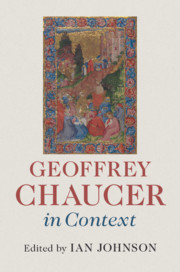Book contents
- Geoffrey Chaucer in Context
- Geoffrey Chaucer in Context
- Copyright page
- Contents
- Illustrations
- Contributors
- Abbreviations
- Introduction
- Part I Chaucer as Context
- Part II Books, Discourse and Traditions
- Part III Humans, the World and Beyond
- Part IV Culture, Learning and Disciplines
- Part V Political and Social Contexts
- Chapter 34 Dissent and Orthodoxy
- Chapter 35 The Church, Religion and Culture
- Chapter 36 England at Home and Abroad
- Chapter 37 Chaucer’s Borders
- Chapter 38 Rank and Social Orders
- Chapter 39 Chivalry
- Chapter 40 Chaucer and the Polity
- Chapter 41 The Economy
- Chapter 42 Towns, Villages and the Land
- Chapter 43 London’s Chaucer
- Chapter 44 Everyday Life
- Chapter 45 Household and Home
- Chapter 46 Marriage
- Chapter 47 Dress
- Part VI Chaucer Traditions
- Further Reading
- Index
Chapter 46 - Marriage
from Part V - Political and Social Contexts
Published online by Cambridge University Press: 24 June 2019
- Geoffrey Chaucer in Context
- Geoffrey Chaucer in Context
- Copyright page
- Contents
- Illustrations
- Contributors
- Abbreviations
- Introduction
- Part I Chaucer as Context
- Part II Books, Discourse and Traditions
- Part III Humans, the World and Beyond
- Part IV Culture, Learning and Disciplines
- Part V Political and Social Contexts
- Chapter 34 Dissent and Orthodoxy
- Chapter 35 The Church, Religion and Culture
- Chapter 36 England at Home and Abroad
- Chapter 37 Chaucer’s Borders
- Chapter 38 Rank and Social Orders
- Chapter 39 Chivalry
- Chapter 40 Chaucer and the Polity
- Chapter 41 The Economy
- Chapter 42 Towns, Villages and the Land
- Chapter 43 London’s Chaucer
- Chapter 44 Everyday Life
- Chapter 45 Household and Home
- Chapter 46 Marriage
- Chapter 47 Dress
- Part VI Chaucer Traditions
- Further Reading
- Index
Summary
Marriage in Chaucer’s time – how it was defined, created, and who could get married – was significantly different from what it is today. Chaucer clearly knew the canon law of marriage, promulgated through preaching and enforced via the church courts. It was incredibly easy to get married (even, perhaps, unintentionally), through words or deeds, such as exchanging rings like Troilus and Criseyde, or having sex while engaged. However, divorce, in the modern sense of voluntarily ending a valid marriage, did not exist. Joan of Kent’s marriage history illustrates how a clandestine marriage, although strictly prohibited, would still be held up in court and could overturn a subsequent, properly publicised, marriage. Second marriages, to the dismay of the Wife of Bath, were regarded as lesser, as their religious symbolism was flawed. The Church wanted exogamy (marrying outside the wider kinship group) but the main concern for many people was maintaining and increasing their social status.
Keywords
- Type
- Chapter
- Information
- Geoffrey Chaucer in Context , pp. 385 - 392Publisher: Cambridge University PressPrint publication year: 2019

